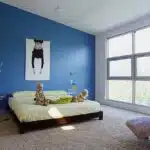Choosing the right color for your carpet is an important decision that can greatly impact the overall look and feel of your space. As a carpet design expert, I understand the importance of selecting a color that not only complements your existing decor but also conveys a certain mood or atmosphere.
The process of choosing a carpet color can seem overwhelming with so many options available. However, by considering factors such as the room’s purpose, lighting, and existing color scheme, you can make an informed decision that will enhance the beauty and functionality of your space. In this article, we will explore various tips and strategies to help you choose the perfect carpet color for your home or office.
Understanding The Importance Of Carpet Color
When selecting a carpet color, it is vital to understand the psychology behind color choices. Color has a profound effect on our emotions and behavior, and thus, it is crucial to choose a color that will create the desired atmosphere in a room. Each color has its unique psychological attributes, which can influence mood and perception. For example, blue is calming and promotes relaxation, while red energizes and stimulates appetite.
The impact of carpet color on home value should also be considered. Carpeting is an investment that impacts both the aesthetics and functionality of your home. The right carpet color can enhance the overall look of your space while simultaneously increasing its value. Conversely, choosing the wrong shade may have an adverse effect on your home’s resale value.
As a carpet design expert, I recommend taking time to consider the various factors involved in selecting a carpet color. It is essential to assess not only personal preferences but also how the chosen shade complements existing decor elements such as walls, furniture, and accessories. With this understanding in mind, you can confidently choose a carpet color that meets both your aesthetic goals and functional needs for years to come. As you assess the room’s purpose in choosing your carpet color, keep these factors in mind for optimal results.
Assessing The Room’S Purpose
When choosing a carpet color, it is essential to consider the room’s functionality. Different rooms will have different purposes and will require various types of carpets that can cater to their needs. For example, a carpet in the living room should be durable enough to withstand heavy foot traffic, while a bedroom carpet should be soft and comfortable underfoot. Understanding the room’s purpose can help you choose the right type of carpet that will meet your needs.
Apart from considering the room’s functionality, it is also essential to conduct a lifestyle assessment. Your lifestyle can significantly affect your choice of carpet color. If you have young children or pets, for instance, you may want to choose a darker color that can hide spills and stains better. On the other hand, if you are someone who likes entertaining guests frequently, then choosing a lighter color may be more suitable as it creates an inviting atmosphere.
In summary, when selecting a carpet color for your home, assessing the room’s purpose and conducting a lifestyle assessment are crucial steps to take. By doing so, you can ensure that your carpet not only looks great but also performs well over time. The next step in this process is determining the mood or atmosphere that you want to create in your home with your chosen carpet color.
Determining The Mood Or Atmosphere
Assessing the Room’s Purpose is an important first step when choosing a carpet color, but it’s not the only factor to consider. Determining the Mood or Atmosphere of the room is equally crucial as it sets the tone for everything else in the space. When it comes to creating a mood or atmosphere through carpet color, there are a few key things to keep in mind.
Firstly, Creating contrast can be an effective way to set a particular mood in a room. For instance, pairing light-colored carpets with dark walls creates drama and sophistication, while pairing dark carpets with light walls creates a cozy and inviting atmosphere. Secondly, Using color psychology can also help you select a carpet that supports your desired mood. For example, blue is calming and serene while yellow is cheerful and energizing. Lastly, don’t be afraid to experiment with bold colors if you’re looking for a statement piece or want to create an accent wall around your carpet.
When selecting your carpet color based on mood or atmosphere factors, remember that it’s all about striking the right balance between your personal preferences and what will work best for your space. Be patient and take your time as finding the right balance may require some trial and error.
Considering existing decor and color scheme is another important aspect to consider when selecting your carpet color. By incorporating some of the existing colors in your space into your carpet choice, you can create harmony throughout the room. This does not necessarily mean matching exactly but rather complementing existing colors in subtle ways that enhance the overall look of the space. Keep these tips in mind when selecting your next carpet color and you’ll be sure to create a stunning addition to any room!
Considering Existing Decor And Color Scheme
Did you know that color psychology plays a significant role in interior design? According to a study by the University of Texas, color can impact our mood and behavior. Therefore, when it comes to choosing your carpet color, it is essential to consider how it will affect the overall aesthetic and energy of your space.
Once you have assessed the existing decor and color scheme of your room, you can select a complementary or contrasting carpet color. If your current decor incorporates bold accent pieces such as pillows or artwork, consider choosing a neutral carpet color like beige or gray to balance out the space. On the other hand, if your room is primarily neutral, adding a pop of color with an accent carpet can create excitement and interest.
Color psychology also plays into how lighting affects our perception of colors. For example, natural light tends to enhance warm tones like reds and yellows while making cool tones like blues appear duller. Artificial lighting can also alter the appearance of colors in a room. To ensure that your chosen carpet color looks good under all lighting conditions, it is crucial to analyze the lighting in your space before making a final decision on which hue works best for you.
With these factors considered, you can confidently choose a carpet color that not only matches but enhances the existing decor and energy of your home. In the next section, we will explore how analyzing lighting can further help you make an informed decision about your carpet choice.
Analyzing The Lighting
After considering the existing decor and color scheme of your room, the next step is to analyze the lighting. Lighting can greatly affect how a carpet color appears in a space. By assessing natural light sources and using artificial lighting, you can determine which colors will work best for your room.
Assessing natural light is essential when choosing a carpet color. Natural light sources can change throughout the day, affecting the appearance of colors in a room. For example, south-facing rooms tend to have warmer natural light while north-facing rooms have cooler light. It’s important to consider these factors when selecting a carpet color as it can greatly impact how it looks in your space.
In addition to natural light, artificial lighting should also be considered when selecting a carpet color. Different types of bulbs emit different hues of light which can affect how colors appear in a room. If you plan on using lamps or other forms of artificial lighting, it’s important to test out different bulb types with potential carpet samples to ensure that the color works well under all types of lighting conditions. By taking these steps to assess both natural and artificial lighting, you’ll be able to choose a carpet color that looks great in any type of light.
When choosing a neutral color for your carpet, there are some important factors to consider. Neutral colors such as beige or gray can create a calming environment and provide versatility when it comes to decorating with other accent colors. However, it’s important to make sure that the neutral shade you select complements the existing decor and color scheme of your room. Additionally, be aware that neutral shades may show dirt and stains more easily than darker colors, so regular cleaning may be necessary. Overall, choosing a neutral shade for your carpet is an excellent choice if you’re looking for something timeless and versatile for your space.
Choosing A Neutral Color
When it comes to choosing the right carpet color, there are many factors to consider. One of the most popular choices for homeowners is a neutral color. Neutral colors offer several advantages over bold colors, including versatility and ease of coordination with other design elements in a room. However, there are also some potential drawbacks to choosing a neutral color that should be considered.
Pros of Choosing a Neutral Color:
- Versatility: Neutral colors such as beige, gray, and taupe can work well with a wide range of other colors and design styles.
- Timelessness: Neutral colors tend to be more timeless than bold colors, which can go in and out of fashion quickly.
- Coordination: It’s often easier to coordinate furniture, accessories, and other design elements when working with a neutral color palette.
Cons of Choosing a Neutral Color:
- Lack of visual interest: While neutrals can be versatile and timeless, they may not make as much of an impact as bolder colors.
- Dirt and stains: Lighter neutral colors may show dirt and stains more easily than darker or patterned carpets.
- Boredom factor: Some people may find neutrals boring or unexciting.
Neutral vs. Bold: Which is the Best? Ultimately, the decision between choosing a neutral or bold carpet color will depend on personal preference as well as the specific needs and style of the room. Homeowners who want a classic look that won’t go out of style may prefer neutrals, while those who want to make a statement with their flooring might opt for something bolder. Regardless of which choice is made, it’s important to consider all options before making a final decision.
Adding A Pop Of Color
- When selecting a bright color for a carpet, consider the size and shape of the room, as well as the amount of natural light that is present.
- Choosing a light or neutral colored carpet in a smaller space can create a more spacious feel.
- While a bold color can be a great way to make a statement, it’s important to ensure the carpet selection complements the existing color palette of the room.
- If the goal is to make a room appear larger, lighter colors are recommended, while if the goal is to make a room feel more cozy and intimate, then darker colors are suggested.
Choosing A Bright Color
As a carpet design expert, I understand the need to add a pop of color to your space. Choosing a bright colored carpet can be an excellent way to achieve this goal. Bright colors like red, yellow, or orange can liven up your room and make it more inviting. However, it’s important to weigh the advantages and disadvantages before making your final decision.
One advantage of choosing a bright colored carpet is that it can add character and personality to your space. If you have neutral walls and furniture, a vibrant rug can serve as the focal point of the room, creating interest and depth. On the other hand, one disadvantage of choosing a bright colored carpet is that it may not match with all furniture styles or wall colors. Therefore, you must take into consideration the existing elements in your room before selecting the shade.
When maintaining a bright colored carpet, there are some tips you should consider. First off, vacuum regularly to prevent dirt from settling into the fibers. Secondly, if you happen to spill something on your rug, clean it up immediately with warm water and mild detergent. Lastly, avoid direct sunlight exposure as this may cause fading over time. With these maintenance tips in mind, you can enjoy your beautiful brightly colored carpet for years to come!
Match The Room’s Color Scheme
When it comes to adding a pop of color to your space, matching the room’s color scheme is an essential consideration. As a carpet design expert, I understand the importance of color psychology and how it influences the overall ambiance of any given space. One way to achieve this is by selecting a bright colored carpet that complements or contrasts with the existing elements in the room.
Matching the room’s color scheme can be achieved through contrasting colors. For example, if your walls are light-colored, a dark-colored rug can create contrast and make your space look more interesting. On the other hand, if you have dark-colored walls and furniture, a brighter rug can create balance and harmony in your space. It’s important to note that while contrasting colors can add depth and character, they must still harmonize with each other for an overall cohesive look.
One thing to consider when selecting a carpet that matches your room’s color scheme is to choose hues from within the same color family. This will create harmony and prevent clashing colors. Additionally, incorporate patterns or textures that complement or contrast with your existing decor elements for added interest. By doing so, you’ll be able to create an aesthetically pleasing space that reflects your personality without creating visual chaos.
Using Shades Of Gray
As the old saying goes, “gray is the new black.” Gray has become a popular choice for carpet color in recent years, as it provides a subtle and sophisticated base that can complement a variety of design styles. When compared to other neutral colors like beige or taupe, gray tends to have cooler undertones that can help create a calming and tranquil atmosphere.
Incorporating gray into patterned carpets can be a great way to add visual interest without overwhelming a room. Using shades of gray in different patterns or textures can create depth and dimension while still maintaining a cohesive color scheme. Gray also pairs well with bold accent colors, allowing you to incorporate pops of color without creating an overly busy or chaotic look.
When selecting your carpet color, it’s important to consider the overall style and mood you want to achieve in your space. While gray may not be as exciting as some bolder colors, it’s versatility allows it to work well in both traditional and modern settings. And don’t worry – for those who still crave vibrant hues, there are plenty of ways to embrace bold colors in other elements of your decor.
Embracing Bold Colors
Bold colors can breathe new life into any room, but it’s important to weigh the pros and cons before making a final decision. One of the biggest advantages of bold colors is that they make a statement and can add personality to an otherwise bland room. They can also create a sense of drama or excitement, which is perfect for entertaining spaces like living rooms or dining rooms.
On the other hand, bold colors can be overwhelming if not used in moderation. They may clash with other elements in the room, such as furniture or artwork, and may not suit everyone’s taste. Additionally, they may be more difficult to match with other design elements and may limit your options for future updates or changes.
If you’re considering embracing bold colors in your carpet choice, some trending options include deep jewel tones like emerald green or sapphire blue, as well as rich earthy hues like terracotta or mustard yellow. These colors work well when paired with neutral walls and furniture to balance out their intensity. Alternatively, consider using bold colors in smaller doses through accents like throw pillows or area rugs.
In order to truly make a statement with your carpet choice, consider exploring patterns and textures in addition to color. This will add depth and interest to your space while still allowing you to incorporate bold hues in a more subtle way. From geometric designs to plush shag carpets, there are endless possibilities for incorporating pattern and texture into your flooring choices.
Exploring Patterns And Textures
When choosing a carpet, it’s important to consider the texture options available. Texture can greatly affect the look and feel of a room, making it essential to select one that complements the overall aesthetic. Some popular textures include loop pile, cut pile, and cut-loop pile. Each has its own unique characteristics that can add depth and interest to your space.
Loop pile carpets are made from loops of yarn that create a textured surface. They’re durable and work well in high-traffic areas, but may not be as soft underfoot as other options. Cut pile carpets have cut yarns that give them a plush appearance, making them ideal for bedrooms or cozy living spaces. Cut-loop piles combine both types of yarn for a more complex texture that can hide dirt and stains better than other styles.
In addition to considering texture, selecting patterned carpets is another way to add visual interest to your floors. There are endless possibilities when it comes to patterns, from bold geometric shapes to delicate floral designs. When choosing a patterned carpet, consider the size of the room and the existing decor. A small space may benefit from a subtle pattern or no pattern at all, while a larger room can handle bolder designs without feeling overwhelming. Ultimately, choosing a patterned carpet should reflect your personal style while also enhancing the overall look of your home.
Moving forward into our next section about going with classic colors, we’ll explore how choosing timeless hues can ensure longevity in your carpet selection.
Going With Classic Colors
Classic colors for carpets have been popular for decades and continue to be a top choice in most households. They are generally neutral shades that blend well with any interior decor, making them a versatile option for those who want to change their furniture or wall color frequently. Timeless colors such as beige, ivory, gray, and navy blue are some of the classic carpet shades that never go out of style.
Timeless carpet hues have several advantages over trendy colors. First, they provide a sense of tranquility and serenity. Neutral tones create a calm atmosphere in your home, which is especially important in bedrooms or living rooms where you want to relax after a long day. Additionally, classic colors help make small spaces appear larger and more spacious by reflecting light around the room.
The psychology of color plays an essential role when choosing the perfect carpet color for your space. Colors can impact our mood, emotions and even our behavior. Neutral tones such as beige or gray promote feelings of calmness and relaxation while navy blue provides a sense of elegance and sophistication to your room’s decoration. Before buying your new carpet, consider how you want your space to feel and what message you want it to convey.
- How to incorporate classic colors into modern decor
- The best classic color combinations for different room types
- Why timeless carpet shades remain popular among homeowners
When considering which color would be best suited for your carpets, remember that timeless hues offer many benefits over trendy colors while also catering to different moods and emotions. In the next section, we will explore how selecting the right type of material plays an essential role in choosing the perfect carpet for your home without compromising on functionality or appearance.
Considering The Carpet Material
- When choosing a carpet material, durability and cleaning requirements should be taken into consideration.
- Carpet materials vary in their ability to withstand wear and tear, and in the amount of effort required to clean them.
- Natural fibers like wool, cotton and silk are often more durable than their synthetic counterparts, but may require more intensive cleaning.
- Synthetic carpets, on the other hand, tend to be easier to clean, but may not be as resistant to wear and tear.
Durability
When it comes to choosing the perfect carpet material for your home, durability must be one of your top considerations. A durable carpet can withstand heavy foot traffic, spills, and stains without losing its appearance or quality. It is essential to choose a material that will last long, especially if you have children or pets in your home.
Color psychology plays a significant role in selecting the color of your carpet. Dark-colored carpets tend to hide dirt and stains better than lighter ones, making them ideal for high-traffic areas like hallways and living rooms. However, if you want to create a warm and inviting atmosphere in your space, consider lighter shades like beige or cream. These colors add an air of elegance and sophistication while maintaining the durability of the carpet.
Maintenance tips are crucial when choosing the right color for your carpet. It would be best if you considered how easy it is to clean different colors when deciding on a particular shade. For instance, white or light-colored carpets require frequent cleaning since they show dirt and stains easily. On the other hand, dark carpets may fade over time due to harsh cleaning chemicals used to remove tough stains. Therefore, it is vital to use mild cleaning agents that do not damage the fibers of the carpet while keeping it clean and well-maintained.
Cleaning Requirements
When it comes to selecting the perfect carpet material for your home, there are several factors that you must consider. One of the most critical aspects is the cleaning requirements of the carpet. The type of color and pile height you choose can have a significant impact on how easy or difficult it is to maintain your flooring.
Choosing between light or dark colors can be a daunting task, but it is essential to think about your lifestyle and cleaning habits. Light-colored carpets look elegant and sophisticated, but they require more maintenance than darker shades. They tend to show dirt, stains, and footprints more easily than darker carpets. In contrast, dark-colored carpets can mask dirt better and require less frequent cleaning. However, they may fade faster due to harsh chemicals used in cleaning products.
Another factor that influences the maintenance requirements of a carpet is its pile height. High pile carpets are soft and plush but tend to accumulate dust and dirt quickly. They are more challenging to clean thoroughly, especially if you have pets that shed a lot of fur or young children who spill food or drinks frequently. On the other hand, low pile carpets are easier to maintain as they do not trap dirt as easily as their high-pile counterparts. They also tend to be more durable and last longer than high-pile carpets. Therefore, when choosing a carpet material, it is crucial to consider all these factors before making a final decision on what works best for your needs.
In conclusion, maintaining your carpet’s appearance and quality depends heavily on the color you choose and its pile height. It would help if you thought carefully about what suits your lifestyle best while keeping the durability of the material in mind. By considering these factors when choosing your carpet material, you ensure that it remains looking good for years without compromising its quality or longevity.
Taking Into Account Foot Traffic
Imagine a bustling street where people are constantly moving. The foot traffic is heavy, and the concrete pavement is showing signs of wear and tear. The same thing happens to your carpet when it is placed in high traffic areas. Choosing the right color for these areas is crucial to maintaining its durability and appearance.
When selecting a carpet color for high traffic areas, consider colors that do not show dirt easily. Darker colors such as brown, gray, and navy blue are great choices as they hide dirt and stains well. Neutral colors like beige and tan also work well but may require more frequent cleaning.
It’s important to find a balance between style and durability when choosing a carpet color for high traffic areas. While you want the carpet to look aesthetically pleasing, you also want it to hold up against heavy foot traffic. Consider using patterned carpets with darker colors as they can add character while still being practical. Remember that carpets with solid lighter colors tend to show wear faster than darker shades.
When it comes to choosing a carpet color for high traffic areas, there are plenty of tips and tricks to keep in mind. But if you’re feeling overwhelmed or unsure about which color would be best for your space, consulting with a professional can help make the decision easier.
Consulting With A Professional
Choosing the right carpet color can be a daunting task, especially if you are not familiar with the different types of carpets available in the market. Finding the right professional to guide you through this process can be extremely beneficial. A carpet design expert has vast knowledge and experience in selecting the perfect color, texture, and pattern for their clients’ homes. They understand how colors work together and how they can affect the overall atmosphere of a room.
One of the benefits of consulting with a professional is that they can help you narrow down your choices based on your preferences, lifestyle, and budget. They will assess your needs and recommend suitable options that meet your requirements while ensuring that you get value for money. Additionally, they will take into account factors such as lighting, furniture, and wall colors to ensure that your chosen carpet complements other elements of your home decor.
When finding the right professional to consult with, it is essential to look for someone who is knowledgeable about carpets and has experience working in this field. A reputable company or individual should have a portfolio of past projects that showcase their expertise in designing carpets for different types of homes. They should also have excellent communication skills and be able to listen attentively to your needs while providing sound advice on what works best for you.
Transition: Now that you have found an expert to consult with regarding choosing the right carpet color, it’s time to move onto finalizing your decision.
Finalizing Your Decision
Having consulted with a professional, you now have a better understanding of the various factors to consider when choosing the perfect carpet color for your space. However, you may still find yourself struggling to make a final decision. Indecision can be overwhelming, but it is not uncommon when faced with a wide range of options.
To overcome indecision, it is important to narrow down your choices by considering your personal preferences and the overall aesthetic of your space. Take into account the existing decor and furniture in the room and think about what colors would complement or contrast them. Additionally, seek feedback from friends and family whose opinions you trust. They may offer valuable insights that help you make an informed decision.
Ultimately, once you have narrowed down your options and sought feedback from others, it’s time to finalize your decision. At this point, it’s essential to take a step back and evaluate each option objectively. Consider how each carpet color will look in different lighting conditions throughout the day and how it will wear over time. By taking all these factors into account, you can confidently choose the perfect carpet color that meets both your practical needs and design preferences.
Conclusion
Carpet color is a crucial factor in enhancing the overall aesthetic appeal of any room. When choosing the right carpet color, it is essential to consider various factors such as the room’s purpose, existing decor and color scheme, lighting, carpet material, foot traffic, and consulting with a professional. By taking these aspects into account, you can make an informed decision that complements your interior design style and meets your practical needs.
For instance, let us consider a hypothetical scenario where a homeowner wants to choose a carpet color for their living room. Firstly, they should assess the room’s purpose and determine whether it will be used for relaxation or entertaining guests. They could then decide on a mood or atmosphere they want to create by selecting calm colors like blue or green for relaxation or bold colors like red or orange for entertainment purposes. Next, they could analyze the existing decor and color scheme to ensure that the chosen carpet color complements rather than clashes with other elements in the room.
Moreover, it is crucial to consider lighting as different light sources can affect how colors appear. The homeowner could also take into account the carpet material and foot traffic as some carpets may be more durable than others depending on usage patterns. Finally, consulting with a professional can provide valuable insights into choosing the right carpet color that aligns with design goals while meeting practical considerations.
As a carpet design expert, I recommend homeowners prioritize assessing their space’s purpose when choosing their preferred carpet color. This decision influences all subsequent choices regarding mood/atmosphere considerations and existing decor/color schemes assessments. Additionally, careful consideration of lighting conditions can help avoid unpleasant surprises after installation day. Lastly, seeking out consultation from professionals in this field ensures that homeowners receive guidance about making informed decisions based on their unique circumstances rather than relying exclusively on personal preferences. By following these guidelines conscientiously, homeowners can transform their rooms into spaces that are both aesthetically pleasing and practical for daily use.
Image Credits
- “Colored Carpet with colored wall !” by dpbirds (featured)




























